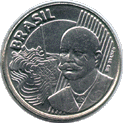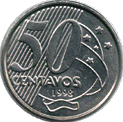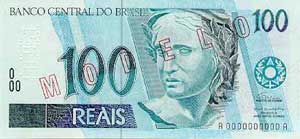|
Ads by Google
REAL (R$) : the Brazilian Currency
Since 1994, the Brazilian currency has been the Real (plural: Reais), symbol is R$.

 Because of the very high inflation rates which Brazil had in the 1980s and early 1990s, the country had to change currency several times: Brazilians were used to dealing with Cruzeiros until 1986; that year, an economic plan cut three zeros from the bills and changed the currency to Cruzado; a few years later, another three zeros were dropped, and Brazilians were introduced to the Cruzados Novos ("new cruzados"). In 1990, the Cruzados Novos were retired, and the Cruzeiros were back; in 1993, the Cruzeiros lost another three zeros and were turned into Cruzeiros Reais.
Because of the very high inflation rates which Brazil had in the 1980s and early 1990s, the country had to change currency several times: Brazilians were used to dealing with Cruzeiros until 1986; that year, an economic plan cut three zeros from the bills and changed the currency to Cruzado; a few years later, another three zeros were dropped, and Brazilians were introduced to the Cruzados Novos ("new cruzados"). In 1990, the Cruzados Novos were retired, and the Cruzeiros were back; in 1993, the Cruzeiros lost another three zeros and were turned into Cruzeiros Reais.
In 1994, after the deployment of a new monetary plan, the new currency, called Real, came to life. Read more about
the Real Plan, which preceeded the launching of the Real.
Since 1994, inflation has been maintained at civilized levels (2003, consumer prices rose by about 8%; in 2005, the inflation target is around 6%), and the Brazilian citizens had the chance, for the first time in a long period, to get accostumed to a stable currency.
There are bills of R$1, R$2, R$5, R$10, R$20, R$50 and R$100;
click here
to look at the bills. Formerly, the bills were illustrated with images of Historic characters; problem was, however, that the high inflation caused the bills to loose value too fast, and what was supposed to be a hommage turned into a mockery. Nowadays, the bills are illustrated with images of Brazilian animals (the feminine character on one side of all bills is a representation of the Republic).
 Coins exist in values of 1 cent (R$0.01), 5 cents, 10 cents, 25 cents, 50 cents and 1 Real. Coins vary in size and color. Since the release of the Real, some coins were discontinued; click the links to check out the
Brazilian coins
in course.
Coins exist in values of 1 cent (R$0.01), 5 cents, 10 cents, 25 cents, 50 cents and 1 Real. Coins vary in size and color. Since the release of the Real, some coins were discontinued; click the links to check out the
Brazilian coins
in course.
The currencies market
Differently from most countries, Brazilians are not used to seeing foreigner currency bills; even the American dollar and the euro have limited course; traveller checks are also restricted (usually, foreigners must exchange the currency before paying their bills, in Reais). Brazilians have no authorization to have bank accounts in dollar; Brazilian firms (including hotels) must provide invoices and receipts in Reais.
Currency exchange businesses exist in all major cities. "Casas de Cambio" are establishments that deal only with currencies; a few branches of a few banks also trade currencies, but not at an advantageous rate to the customer.
Brazilian banks
have developed an efficient Information Technology infrastructure; holders of major credit cards can use Brazilian ATMs to access their accounts and withdraw cash (other transactions are limited).
Click the link to check out the
exchange rate of dollar against Real
for the past years.
Back to Top
|
|